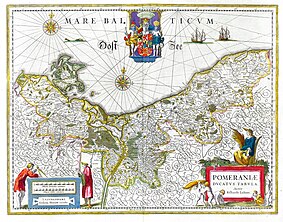
The Duchy of Pomerania was partitioned several times to satisfy the claims of the male members of the ruling House of Pomerania dynasty.[1] The partitions were named after the ducal residences: Pomerania-Barth, -Demmin, -Rügenwalde, -Stettin, -Stolp, and -Wolgast. None of the partitions had a hereditary character,[2][3] the members of the House of Pomerania inherited the duchy in common.[2] The duchy thus continued to exist as a whole despite its division.[2] The only exception was made during a war with the Margraviate of Brandenburg, when in 1338 Barnim III of Pomerania-Stettin was granted his partition as a fief directly from the Holy Roman Emperor, while Pomerania-Wolgast remained under formal Brandenburgian overlordship.[4][5] However, already in 1348, German king and later emperor Charles IV again granted the Duchy of Pomerania as a whole and the Principality of Rügen as a fief to the dukes of both Pomerania-Stettin and Pomerania-Wolgast, nullifying Brandenburg's claims by granting Imperial immediacy.[5][6]
- ^ Kyra T. Inachin, Die Geschichte Pommerns, Hinstorff Rostock, 2008, p.30, ISBN 978-3-356-01044-2
- ^ a b c Norbert Buske, Pommern, Helms Schwerin 1997, p.21, ISBN 3-931185-07-9
- ^ Gerhard Krause, Siegfried M Schwertner, Horst Balz, Gerhard Müller, Theologische Realenzyklopadie: Studienausgabe Teil II, 2nd edition, De Gruyter, 1999, p.40, ISBN 3-11-016295-4
- ^ Werner Buchholz, Pommern, Siedler, 1999, pp.107-109, ISBN 3-88680-272-8
- ^ a b Kyra Inachim, Die Geschichte Pommerns, Hinstorff Rostock, 2008, p.32, ISBN 978-3-356-01044-2
- ^ Werner Buchholz, Pommern, Siedler, 1999, pp.110-111, ISBN 3-88680-272-8
